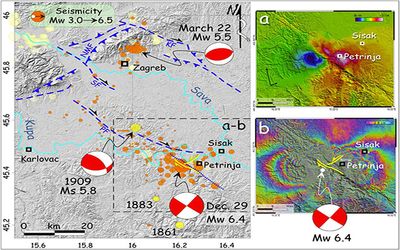On April 29, a study published on Scientific Reports entitled "Coseismic surface "conjugate" faulting of the 29 December 2020., MW 6.4, Petrinja earthquake (Sisak-Moslavina, Croatia)" will be presented during the EGU special session "Late-Breaking Session: The December 2020 earthquake sequence in Petrinja, Croatia, and its seismotectonic and geodynamic environments (15.30-17.00).
The study provides a first-hand description of the coseismic surface effects caused by the Mw 6.4 Petrinja earthquake that hit central Croatia on 29 December 2020. This was one of the strongest seismic events that occurred in Croatia in the last two centuries. Field surveys in the epicentral area allowed us to observe and map primary coseismic effects, including geometry and kinematics of surface faulting, as well as secondary effects, such as liquefaction, sinkholes and landslides. The resulting dataset consists of homogeneous georeferenced records identifying 222 observation points, each of which contains a minimum of 5 to a maximum of 14 numeric and string fields of relevant information. The earthquake caused surface faulting defining a typical ‘conjugate’ fault pattern characterized by Y and X shears, tension cracks (T fractures), and compression structures (P shears) within a ca. 10 km wide (across strike), NW–SE striking right-lateral strike-slip shear zone (i.e., the Petrinja Fault Zone, PFZ). We believe that the results of the field survey provide fundamental information to improve the interpretation of seismological, GPS and InSAR data of this earthquake. Moreover, the data related to the surface faulting may impact future studies focused on earthquake processes in active strike-slip settings, integrating the estimates of slip amount and distribution in assessing the hazard associated with capable transcurrent faults.
The talk, as scheduled (https://meetingorganizer.copernicus.org/EGU21/session/41372) is: 16:05–16:07: Coseismic surface "conjugate" faulting of the 29 December 2020., MW 6.4, Petrinja earthquake (Sisak-Moslavina, Croatia). Emanuele Tondi, Anna Maria Blumetti, Mišo Čičak, Pio Di Manna, Zoran Đuroković, Paolo Galli, Chiara Invernizzi, Stefano Mazzoli, Luigi Piccardi, Giorgio Valentini, Eutizio Vittori, and Tiziano Volatili.
Reference: Tondi, E., Blumetti, A.M., Čičak, Di Manna P., Galli P., Invernizzi C., Mazzoli S., Piccardi L., Valentini G., Vittori E., Volatili T., 2021. ‘Conjugate’ coseismic surface faulting related with the 29 December 2020, Mw 6.4, Petrinja earthquake (Sisak-Moslavina, Croatia). Scientific Reports, 11, 9150 (2021), 1-15. https://doi.org/10.1038/s41598-021-88378-2.
